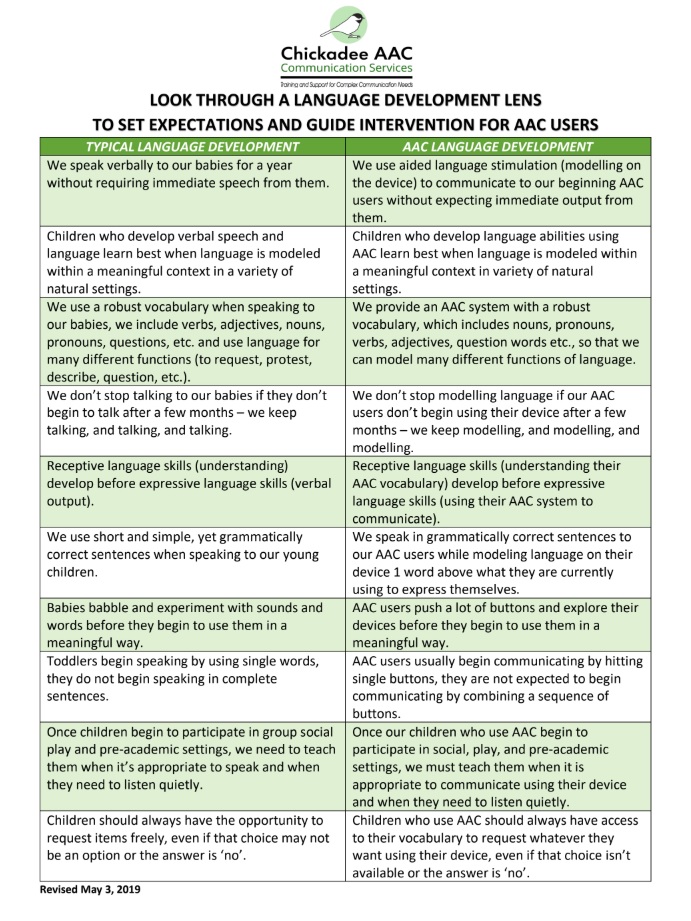AAC Through a Language Lens
Prevent unrealistic expectations and AAC device abandonment by teaching school teams that they are supporting the development of their students’ language abilities.
“He’s had his AAC device for over a month now and all he does is tap random buttons, he doesn’t understand what the symbols mean.”
“She’s constantly pressing buttons on her AAC device while the teacher is talking, it’s very disruptive to the other students in the class.”
“I’ve been using aided language input to model words on my student’s AAC device for at least 3 months, and he still doesn’t know how to use it ‘properly’.”
“He constantly presses the “YouTube” button on his AAC device; he isn’t allowed to watch it at school, so he gets frustrated and his behaviours escalate. I deleted that button choice from his vocabulary to minimize his behaviours during the school day.”
“There were way too many buttons on her AAC vocabulary, so I hid all but 4 buttons. We are going to practice those over and over until she’s mastered them, then I will add 4 more words to focus on.”
We consistently hear comments like this from educational assistants, team members, and teachers as we travel throughout the school district to consult on our students who have AAC devices.
Why is it so common for teams to quickly give up on a student’s AAC device when the student doesn’t begin to use it expressively within the first few months of receiving it? Why is the bar set so high for AAC users to become proficient communicators within such a short period of time?
From our experience, we’ve discovered that a key perspective helps team members understand what our students with complex communication need to learn to communicate. This key is:
View AAC users’ communication progress from a language development perspective.
The content (or vocabulary) of the AAC system should be considered the student’s language, the device that holds their language is merely the tool.
We view our AAC users’ language growth as similar to the ways speaking children develop language. We review and explain the points outlined in our “Language Development Model” chart.
Language Development Perspective
By recognizing the similarities in development between speaking children and children who use AAC devices, team members often have that “aha moment”. Educational Assistants begin to realize the importance of their role as strong communication partners. They must speak AAC to teach AAC.
Receptive Before Expressive
This perspective also emphasizes that receptive (understanding) of language develops before expressive (output) language, therefore, they must provide consistent input (aided language), without demanding or expecting immediate output.
We always emphasize to our educational assistants that while they are modelling language all day on their student’s device, but they aren’t seeing their student use the device, they are still teaching receptive language! They are teaching an understanding of vocabulary, how it is used within different contexts and the symbols and pathways to access the language in their vocabulary.
Do babies begin speaking at 2 months after hearing us model language? Because the baby doesn’t start speaking right away, do we stop speaking to the baby? If the student isn’t using his device fluently after two months, don’t stop modelling for your student, you are teaching receptive language skills.
Robust Vocabulary Taught in a Natural Context
We don’t limit our language modelled for our babies to only 4 words until they master those 4 words. We provide a language rich environment with many words in many different contexts. Our toddlers begin speaking in single words, so this is an appropriate expectation of our AAC users.
Realistic Expectations Without Limits
Using a language-based perspective, our methods of implementation and our assessment of progress become clear. Children, both speaking and non-speaking, are only going to learn the language that we expose them to.
Don’t put limits on children who have complex communication needs. Give them every opportunity to learn language at an appropriate rate of development, be strong communication partners, and set realistic expectations and the students will surprise you!
Jennifer Wiegert and Corinna Duffitt are registered Speech-Language Pathologists living in Surrey and Langley, British Columbia, Canada. They work on the AAC team for the Surrey School District as well as provide therapy and parent training to clients and their families through their private practice, Chickadee AAC Communication Services. They are passionate about building capacity in school districts by improving the understanding and skills of staff who support students with Augmentative and Alternative Communication systems. They also teach hands-on AAC Labs in two Community College Educational Assistant Programs.


